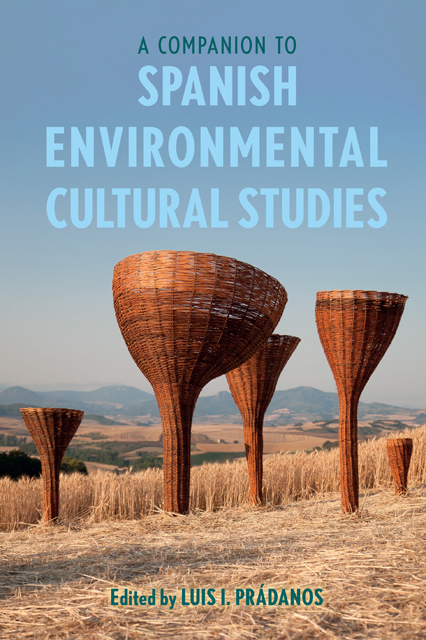Book contents
- Frontmatter
- Contents
- List of Illustrations
- List of Contributors
- Note on the Translations
- Acknowledgements
- Introduction: Spanish Environmental Cultural Studies
- Part I Environmental Cultural History and Political Ecology
- Part II Water and Power
- Part III Ecologies of Memory and Extractivism
- Part IV Animal Studies and Multispecies Ethnographies
- Part V Food Studies and Exploitative Ecologies
- Part VI Ecofeminism
- Part VII (Neo)Colonial and Racialized Ecologies
- Part VIII Tourism and the Environmental Imagination
- Part IX Eco-Mediation and Representation
- Part X Trash and Discard Studies
- Bibliography
- Index
5 - Soil, Water, and Light: Aerial Photography and Agriculture in Spain
Published online by Cambridge University Press: 08 June 2023
- Frontmatter
- Contents
- List of Illustrations
- List of Contributors
- Note on the Translations
- Acknowledgements
- Introduction: Spanish Environmental Cultural Studies
- Part I Environmental Cultural History and Political Ecology
- Part II Water and Power
- Part III Ecologies of Memory and Extractivism
- Part IV Animal Studies and Multispecies Ethnographies
- Part V Food Studies and Exploitative Ecologies
- Part VI Ecofeminism
- Part VII (Neo)Colonial and Racialized Ecologies
- Part VIII Tourism and the Environmental Imagination
- Part IX Eco-Mediation and Representation
- Part X Trash and Discard Studies
- Bibliography
- Index
Summary
André Malroux’s 1945 film Sierra de Teruel, adapted from his novel Éspoir, narrates an episode from the Spanish Civil War in which Malroux participated as a war pilot in charge of organizing the Republican army’s Air Force. The film’s narrative, which centers on the efforts of the Republican soldiers, aided by local villagers, to locate a contingent of Nationalist warplanes hidden in a field near Teruel, is organized around two types of movement: up and down, elevation and descent. While the central portion of the film takes place in the air, inside the Republican planes that are surveying the mountainous terrain and subsequently circling down on the Nationalist position, its final section depicts the laborious descent of the villagers, who carry the bodies of dead and wounded Republican soldiers down a rugged mountain, back to the village.
Of particular interest for this essay is the way in which the film juxtaposes two diverging perspectives on the events, which take place and are seen both from the air and from the ground. While both sets of events are protagonized jointly by the Republican militias and the local population, a single character – the peasant who accompanies the pilots to help locate the Nationalist position – embodies the nature of the aerial vision; the way it changes one’s relationship with the ground, distancing and defamiliarizing the land. In the central sequence of the film, the distressed peasant tries, and almost fails, to relate the moving patches of the land seen from above to the fields he knows like the back of his hand. Seen from the air, the land is not a material foundation of people’s lives, but a continuous surface that requires interpretation. In contrast, the slow descent of the villagers accompanying the wounded and dead – a descent that repeats the downward movement of the crashing Republican plane and leads the fallen milicianos to their final resting place – refocuses the narrative on the connection between the land and the people who live and die on it. The bond between the land and the people is encapsulated in the sentence “We do what we can,” heard at various points in the film until it becomes a slogan, an expression of the common sense and determination with which the peasants place their scarce resources at the service of the Republican cause.
- Type
- Chapter
- Information
- A Companion to Spanish Environmental Cultural Studies , pp. 68 - 76Publisher: Boydell & BrewerPrint publication year: 2023
- 1
- Cited by



